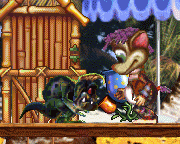Saturday, August 20, 2011
Genetics Discussion: Forest Norns Part 1
"Forest Norns are a new breed of Norn, related to the Purple Mountain Norns. The male and female are quite different:
"Male: New genes provide the male Forest Norns with a curious dreamer appearance. They tend not to react harshly, and prefer instead the simple, peaceful solution to problems.
"Female (Nancy): Female Forest Norns have larger concept lobes in the brain than any other Norn. Their neuron dynamics are quite different, leading to increased intelligence and bigger memories. Stress ages female Forest Norns rapidly, so it should be avoided."
This is an overview of the genetic differences between Forest Norns and regular hatchery Norns. Once again, the Forest genes are listed first, followed by the equivalent gene in the normal genome.
In addition to the changes described here, Forest Norns also include the genes for geddonase poisoning and dancing described in the discussion on Purple Mountain Norns.
Brain Lobes
122 7 0 Emb B Mut Lobe #= 8 at X=11 Y=5 is 42 neurons wide and 18 neurons high. Perflags=0. Dendrite Type 0: Input Lobe=0, Min#=1, Max#=5, Spread=1, Fanout=2
122 7 0 Emb B Mut Lobe #= 8 at X=12 Y=6 is 40 neurons wide and 16 neurons high. Perflags=0. Dendrite Type 0: Input Lobe=0, Min#=1, Max#=3, Spread=3, Fanout=2
Whew! There's a lot going on in this gene! Let's start with the simple things. The X and Y values determine the location of the brain lobe, and the height and width determine its size. This is the "expanded concept lobe" touted by the description. Notice, however, that the gene is still marked "B," which means it is expressed in both males and females.
The Forest Norn concept lobe also has a higher "Max" value. This is the maximum number of dendrites that connect the concept lobe to its source lobe, the perception lobe. That means that a Forest Norn can make more connections between these two lobes and should be able to learn concepts better.
The "Spread" value describes how dendrites are able to make connections between the lobes. In normal Norns, this is set to the "waS" pattern, while in Forest Norns, it is set to "normal." Unfortunately, even after extensive Googling, I'm still not sure what is means beyond that fact that, in Forest Norns, the perception and concept lobes are wired up slightly differently. Perhaps I'll come back to this at a later time.
Receptors
325 44 0 Emb B Creature, Circulatory, floating chem 2, chem=Glycogen, thresh=0, nom=0, gain=255, features=Analogue
327 45 0 Sen B Creature, Somatic, die of old age, chem=Ageing, thresh=5, nom=117, gain=255, features=Inverted Digital
These are two novel genes in the Forest genome. The first of these is a receptor that stores the level of glycogen in the Norn's system. This will come into play below. The second is the "die of old age" gene. This causes the Norn to die when its level of ageing chemical reaches a certain point. All of my Norns have a variation of this gene. It may be counter intuitive, but many people consider the inclusion of this gene kinder than its exclusion. The original hatchery Norns could only die of starvation or poisoning. They would "die of old age" when they grew old and refused to eat.
Emitters
326 28 0 Emb B MutDup Creature, Circulatory, floating chem 2, chem=Hunger, thresh=0, samp=5, gain=2, features=Inverted Analogue
This is another new gene, and the other half of the way hunger is controlled in Life Kit Norns. This emitter releases hunger based on the level of glycogen in the Norn's system. Remember that glycogen is the long-term energy storage chemical in C1 and the chemical that determines a Norn's life force. Life Kit Norns become hungry when their glycogen is low and don't become hungry when their glycogen is high.
Reactions
58 2 0 Emb B MutDupCut 1*NFP++ + 1*<NONE> => 1*NFP + 1*<NONE>; half-life = 8.
58 2 0 Emb B MutDupCut 1*NFP++ + 1*<NONE> => 1*NFP + 1*Punishment; half-life = 8.
59 3 0 Emb B MutDupCut 1*Hunger++ + 1*<NONE> => 1*Hunger + 1*<NONE>; half-life = 8.
59 3 0 Emb B MutDupCut 1*Hunger++ + 1*<NONE> => 1*Hunger + 1*Punishment; half-life = 8.
62 6 0 Emb B MutDupCut 1*Tiredness++ + 1*<NONE> => 1*Tiredness + 1*<NONE>; half-life = 8.
62 6 0 Emb B MutDupCut 1*Tiredness++ + 1*<NONE> => 1*Tiredness + 1*Punishment; half-life = 8.
64 7 0 Emb B MutDupCut 1*Sleepiness++ + 1*<NONE> => 1*Sleepiness + 1*<NONE>; half-life = 8.
64 7 0 Emb B MutDupCut 1*Sleepiness++ + 1*<NONE> => 1*Sleepiness + 1*Punishment; half-life = 8.
68 11 0 Emb B MutDupCut 1*Boredom++ + 1*<NONE> => 1*Boredom + 1*<NONE>; half-life = 8.
68 11 0 Emb B MutDupCut 1*Boredom++ + 1*<NONE> => 1*Boredom + 1*Punishment; half-life = 8.
These reactions all describe how the drive raising chemicals (ex. hunger increase or hunger++) increase the actual drive chemicals. Regular Norns are punished for an increase any of their drives, but Forest Norns are a little more logical: they aren't punished for raising drives that go up on their own over time, like hunger and tiredness. Notice that the pain/pain increase reaction isn't included in this list, so Forest Norns should still learn to avoid situations that cause them pain. ("Should" being the operative word -- all Norns love bees.)
142 27 0 Emb B MutDup 1*Starch + 1*<NONE> => 2*Glucose + 1*Hunger--; half-life = 64.
142 27 0 Emb B MutDup 1*Starch + 1*<NONE> => 2*Glucose + 1*<NONE>; half-life = 64.
144 28 0 Emb B MutDup 3*Glucose + 1*<NONE> => 1*Glycogen + 1*<NONE>; half-life = 56.
144 28 0 Emb B MutDup 3*Glucose + 1*<NONE> => 1*Glycogen + 1*Hunger--; half-life = 56.
145 29 0 Emb B MutDup 1*Glycogen + 1*<NONE> => 3*Glucose + 1*<NONE>; half-life = 64.
145 29 0 Emb B MutDup 1*Glycogen + 1*<NONE> => 3*Glucose + 1*Hunger; half-life = 64.
This series of reactions improves the way digestion influences hunger in Forest Norns. Here, the conversion of starch to glucose prompts a decrease in hunger. Starch is the main energy source found in food in C1. The original C1 Norns didn't derive a hunger decrease from consuming starch. In addition, the conversion of glucose or glycogen and vice versa no longer affects hunger in Forest Norns -- that relationship is controlled by the receptor/emitter pair described above.
146 30 0 Emb B MutDup 1*Glucose + 2*Hexokinase => 4*CO2 + 8*Activase; half-life = 24.
146 30 0 Emb B MutDup 1*Glucose + 2*Hexokinase => 4*CO2 + 1*<NONE>; half-life = 24.
This reaction controls the byproducts of movement and energy use. In Forest Norns, this creates an additional chemical, Activase, which shows up in other Life Kit genes.
292 50 0 Ado B MutDupCut 4*Adrenaline + 1*Ageing => 1*<NONE> + 1*<NONE>; half-life = 128.
292 50 0 Ado B MutDupCut 1*Adrenaline + 1*<NONE> => 1*<NONE> + 1*<NONE>; half-life = 88.
In the regular genome, this reaction simply causes adrenaline to leave the system. In Forest Norns, adrenaline has a nastier effect: it breaks down the ageing chemical, accelerating, well, ageing. Adrenaline is produced when the Norn is stressed, hence why stress ages Forest Norns quickly.
332 64 0 Emb B MutDupCut 8*Adrenaline + 1*Activase => 1*Fear-- + 1*Anger--; half-life = 32.
This novel gene causes Activase, which we saw is produced when energy is used by muscle activity, to react with adrenaline to decrease fear and anger. Moving around reduces stress and calms the Norn down.
This discussion will be continued in a later post!
Labels:
creatures 1,
genetics
Subscribe to:
Post Comments (Atom)



No comments:
Post a Comment